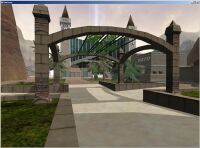| |
Site Navigation
Main
News
Forums
Games
Games Database
Top 100
Release List
Support Files
Features
Reviews
Previews
Interviews
Editorials
Diaries
Misc
Download
Gallery
Music
Screenshots
Videos
Miscellaneous
Staff Members
Privacy Statement
|
|
Jessica Mulligan has written a new Biting the Hand Column, this time dealing with the history of Online Games. Interesting as always. Here's a bit:
The First Generation: 1969 to 1977
I peg the beginning of the first generation in 1969, when Rick Blomme wrote a two-player version of MIT's famous Spacewar for the PLATO service. PLATO (Programmed Logic for Automatic Teaching Operations) was one of the first time-sharing systems, dedicated to experimenting with new ways to use computers for education. Originally built in the late 1960's at the University of Illinois/Urbana, it blossomed into a system that, by 1972, could host about 1,000 simultaneous users. PLATO featured plenty of games over the years, but my research indicates this was the first true multiplayer game on the system. It is also interesting to note that PLATO had graphics capability, as evidenced by Airfight, a two-person 3D dogfighting simulation that first appeared on PLATO around 1973.
Note that Blomme’s Spacewar was done two years before the first commercially available arcade videogame, Computer Space, which was pretty much… Spacewar. 1969 was also the year ARPAnet was founded. You probably know ARPAnet as the homey little system we now call the Internet.
PLATO doesn’t get enough credit for inspiring the online games revolution, or for its effects on computer and videogaming as a whole. For example, the guys who wrote Airfight went on to build Flight Simulator, which was bought by Microsoft in the 1980s and is now Microsoft Flight Simulator, one of the best-selling PC games of all time. The service also had one of the first 32-player versions of the venerable Empire circa 1974, a game that developers still imitate today (think "turn-based and/or real-time strategy"), and Oubliette, circa 1975-1978, which was a dungeon crawl that inspired the Wizardry series that is still with us today. And it’s pretty obvious that Spacewar inspired Nolan Bushnell to create Computer Space in 1971 and then to go on to found Atari a year or two later.
During this first generation, there was plenty of experimentation with multiplayer games on various platforms, operating systems and languages. Most of it took place at major university mainframe computers at places like MIT, the University of Virginia and Essex University in Colchester, England, where the Second Generation begins. |
|
|





 Biting the Hand: History of Online Games
Biting the Hand: History of Online Games